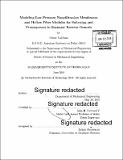| dc.description.abstract | Recently, interest in nanofiltration (NF) has been surging, as has interest using it as a technology for better brine management and pretreatment in reverse osmosis (RO) plants. Using NF for pretreatment reduces fouling and scaling in RO units, allowing for potentially higher recoveries. This lowers the environmental impact of RO by decreasing the amount of water to be treated per unit volume of water produced, and reducing the volume of RO brine to be managed. This can potentially curb the CO2 emissions resulting from the RO desalination process. A novel class of low-pressure nanofiltration (NF) hollow fiber membranes, particularly suited for water softening and desalination pretreatment have lately been fabricated in-house using layer-by-layer (LbL) deposition with chemical crosslinking. These membranes can operate at exceedingly low pressures (2 bar), while maintaining relatively high rejections of multivalent ions. In spite of their great potential, our understanding as to what makes them superior has been limited, demanding further investigation before any large-scale implementation can be realized. In this study, the Donnan-Steric Pore Model with dielectric exclusion (DSPM-DE) is applied for the first time to these membranes to describe the membrane separation performance, and to explain the observed rejection trends, including negative rejection, and their underlying multi-ionic interactions. Experiments were conducted on a spectrum of feed chemistries, ranging from uncharged solutes to single salts, salt mixtures, and artificial seawater to characterize the membrane and accurately predict its performance. Modeling results were validated with experiments, and then used to elucidate the working principles that underly the low-pressure softening process. An approach based on sensitivity analysis shows that the membrane pore dielectric constant, followed by the pore size, are primarily responsible for the high selectivity of the NF membranes to multivalent ions. Surprisingly, the softening process is found not to be sensitive to changes in membrane charge density. Our findings demonstrate that the unique ability of these membranes to exclusively separate multivalent ions from the solution, while allowing monovalent ions to permeate, is key to making this lowpressure softening process realizable. Given its high surface area to volume ratio and desirable mass transfer characteristics, the hollow fiber module configuration has been central to the development of reverse osmosis (RO) and ultrafiltration (UF) technologies over the past five decades. Following the development of the LbL membrane, interest in their scale-up implementation for softening and desalination pretreatment has been growing. Further progress on large-scale deployment, however, has been restrained by the lack of an accurate predictive model, which is pivotal to guiding module design and operation. Earlier models targeting hollow fiber modules are only suitable for RO or UF technologies, and no appropriate NF models have been presented to characterize the performance of hollow fiber modules at the large-scale. In this work, we propose a new modeling approach based on the implementation of mass and momentum balances, coupled with a suitable membrane transport model, such as the Donnan-Steric Pore Model with dielectric exclusion (DSPM-DE), to predict module performance at the system-level. We then propose a preliminary module design, and employ parametric studies to investigate the effect of varying key system parameters and to elucidate the tradeoffs available to the module designer. The model has significant implications for low-pressure nanofiltration, as well as hollow fiber NF module design and operation. An approach based on comparing the marginal increase in system recovery to the marginal increase in transmembrane pressure (TMP) was used to define an optimal operating point. Our findings reveal that increasing the TMP could potentially increase energy savings under some operating conditions. | en_US |
